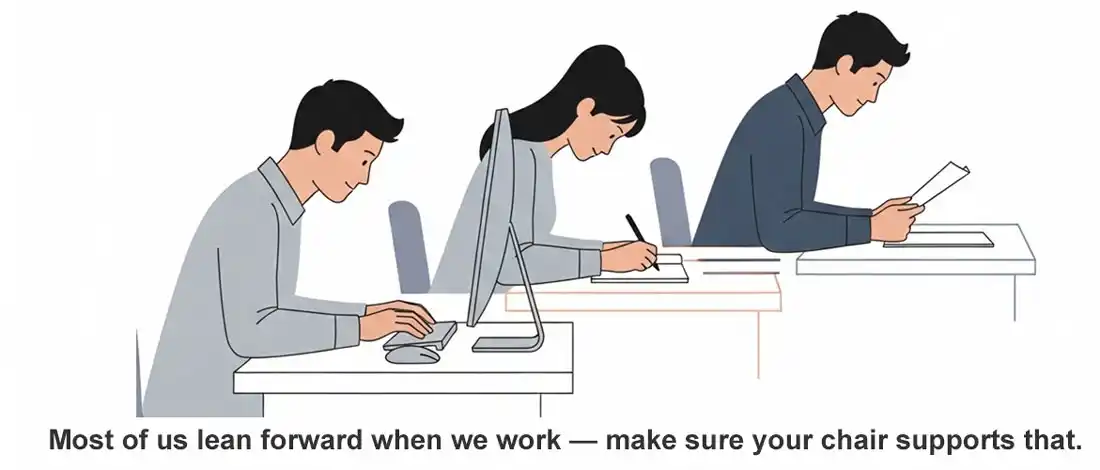The Best Tips to Reduce Back Pain While Working in an Office
Back pain is one of the top reasons office workers lose productivity and feel miserable by midday. Up to 85 percent of people will deal with back pain at some point in their career. The good news: most of it is preventable with the right chair, the right adjustments, and a few smart habits. How do you narrow it down? “The chair should fit you, you shouldn’t have to fit the chair.” — Barry Einhorn Long static sitting compresses the spine, tightens hip flexors, and encourages slouching. Add a chair that doesn’t support your natural curves or a desk that forces your shoulders up or down, and pain shows up fast. Most of us also lean forward when we concentrate. That forward-leaning posture is the reality—not just something graphic designers do. If your chair can’t support that position (or lock you safely there), pressure builds in your lower back and legs. Forward tilt control can be a lifesaver for people with sciatica or varicose veins because it opens the hip angle and improves circulation. And yes, slipping off the front edge of a chair is not funny—get a mechanism that supports you when you lean. We also lean back instinctively when taking or making phone calls. If your job involves frequent calls, consider a headrest. Barry notes, however, that some women who wear their hair up may find headrests uncomfortable. Your chair is your foundation. Focus on features that let the chair conform to you. Spend the money here. A lumbar pad that moves vertically and also adjusts its depth will actually meet your spine, not fight it. Global’s Schukra lumbar system is a great example: you can crank it up or down and fine-tune how far it presses into your lower back. Your legs and spine should form 90-degree angles. Set the seat so your feet rest flat on the floor (or on a footrest) and your knees are at or just below hip level. If you’re shorter, you may need a chair with a shorter gas cylinder. If you’re taller, make sure the cylinder extends high enough without lifting your thighs off the cushion. People with longer legs need a seat slider to move the seat pan forward so the front edge doesn’t press into the backs of the knees. Shorter users slide the seat back so their butt can hit the backrest without a big gap at the knees. Which leads to the next point... Your hips should naturally land against the back of the chair without you thinking about it. If you keep perching on the end of the chair, something is off: adjust the seat slider, lumbar, or tilt until sitting back is effortless. Forward tilt helps reduce pressure on the sciatic nerve and encourages better blood flow in your legs. Recline relieves spinal pressure. Use tilt tension to control how easily the chair rocks. Look for infinite tilt lock so you can freeze the chair at the exact angle that feels best, whether that is a slight recline or a forward working posture. Watch this short video on how to adjust the Multi-Tilter mechanism by Global. It covers seat height, seat depth, lumbar support, tilt lock, and more—all the key controls to dial in your perfect ergonomic setup. https://www.youtube.com/watch?v=_IZCIbPfSmw Height, width and pivot adjustments let you support your forearms without hiking your shoulders or flaring your elbows. If your arms are squeezed or hanging, shoulder and neck tension follow. We instinctively lean back when we make or take phone calls. If calls are a big part of your day, a headrest can help you relax your neck. Barry’s caveat: some women who wear their hair up find headrests annoying. Try before you buy. If you struggle with neck fatigue or tingling, switching to a vertical mouse can reduce the inward shoulder roll that traditional mice encourage. Skip the numbers here—think in categories. Whatever your size, the goal is the same: the chair should meet you where you are. You should not contort to meet the chair. Traditional fixed-height desks were designed for people roughly 5'8 to 5'10. If you’re outside that window, the desk may be forcing bad posture. Lower the keyboard (tray), raise the monitor, or consider a height-adjustable desk so your chair can be set correctly. No chair can erase the effects of sitting all day. Follow a simple rhythm: sit for 20 minutes, stand for 8, move for 2. Walk to the printer, stretch your hips, or do a quick calf raise sequence. Your spine needs movement to stay happy. You do not have to live with back pain at work. With a chair that truly fits you, correct adjustments, and smarter daily habits, you can work comfortably for years. Explore our ergonomic chairs proven to ease back strain and let us help you dial in the perfect setup. If you still feel unsure, reach out. Barry and the team have helped Canadians sit better since 1981. We’ll help you choose the chair that fits you—not the other way around. Ready to feel the difference? Browse our ergonomic selection or contact us for a personalized recommendation.
Why Sitting Triggers Back Pain
Start With The Chair: Features That Actually Reduce Back Pain
Adjustable Lumbar Support (Up/Down and In/Out)
Seat Height
Seat Depth = Seat Slider
Sit All The Way Back

Forward Tilt (Forward Leaning Control)
Backrest Recline, Tilt Tension, and Tilt Lock
Want to see it in action?
Armrests You Can Actually Use
Headrest (Use Case Nuance)

Consider a Vertical Mouse For Neck Pain
Fit The Chair To Your Body: Petite and Big & Tall
Don’t Ignore The Desk
Move More Than You Think
FAQ: What Ergonomic Chairs Can and Can’t Do
Visuals & Infographics To Add
Final Thought & CTA
